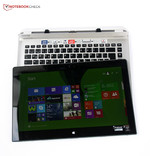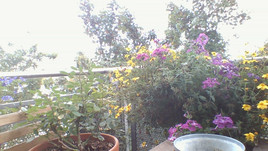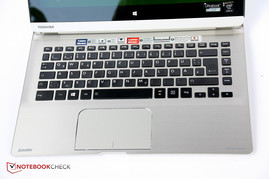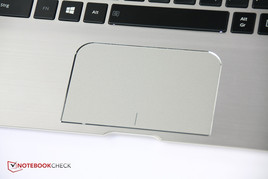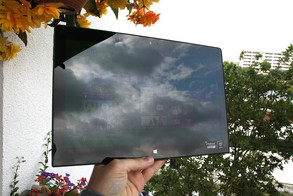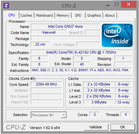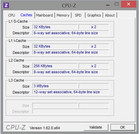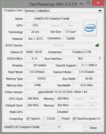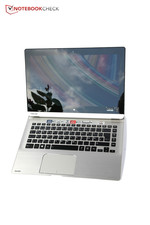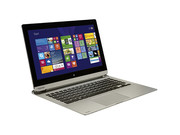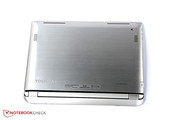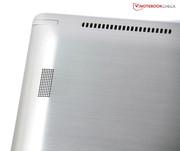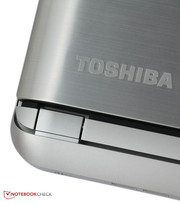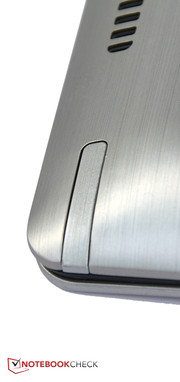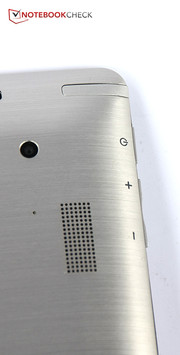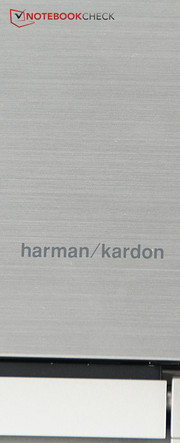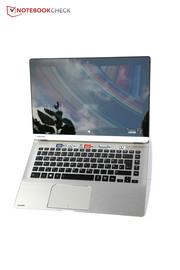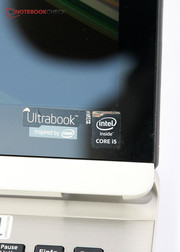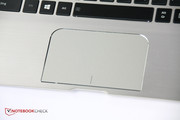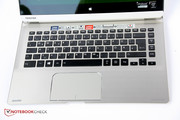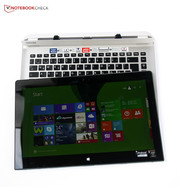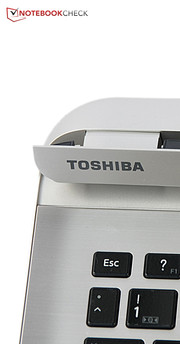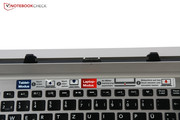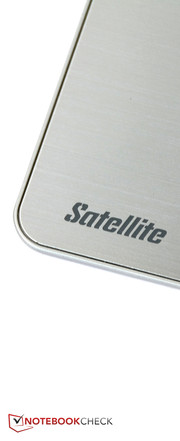Toshiba Satellite Click 2 Pro P30W-B-104 Convertible Review

For the original German review, see here.
Isn't it convenient to always have a convertible at hand? Using a full-sized keyboard for typing longer texts is always possible, but taking the tablet with a touchscreen for browsing on the Internet is handy. The manufacturers are outdoing each other with unusual hinge constructions or by combining a tablet with a keyboard dock so that the touchable screen can be completely removed and used as a tablet in the 2-in-1 concept.
Toshiba pursues the latter design with its Satellite P30W-B-104. The keyboard dock serves as a docking station with additional interfaces, a keyboard, and a touchpad. At the same time, the tablet can be used without the dock owing to the available ports, and because Toshiba installs all internal components like the processor and graphics card in the tablet. That has both advantages and disadvantages, which we will examine in the following test.
Toshiba's Satellite P30W-B-104 currently competes with other 13-inch convertibles in the forms of HP's Split x2 13, Asus' Transformer Book T300LA, Sony's Vaio Fit 13A multi-flip, HP's Spectre 13, and Lenovo's Yoga 2 13 and Yoga 2 Pro.
Case
When we saw Toshiba's Satellite Click 2 Pro P30W-B-104 in a closed state on the table, we were at first uncertain whether it was upside down or not. Since Toshiba wanted to design the tablet's sides as thin as possible, the vents and speaker grilles are on the tablet's back. That disrupts the actually pleasantly plain design and lessens the high-quality impression of the metal casing somewhat. Although the keyboard dock's underside is only plastic, it is at least textured and has a high-quality feel.
The keyboard dock's stylish design is striking when the convertible is opened. It is gently curved toward the keyboard, the ClickPad looks a bit like an archway due to the rounded corners at the top, and the entire frame is made of brushed aluminum. The tablet is inserted into a massive fixture that is comprised of matte aluminum. Since it closes flush with the keyboard dock when closed, our new review sample already exhibited light scratches here. Thus, this component will likely no longer look good after a while of use.
The partly very thin keyboard dock is, unfortunately, not absolutely stiff. The front corners can be warped massively, which occasionally produces a cracking noise, or increases the gap between the ClickPad and bezel. Besides that, the ClickPad's keys can be used by pressing the underside, which does not contribute to the accuracy. The tablet can also be twisted and leads to color distortions on the screen.
An ultrabook sticker adorns the casing, and so Toshiba has followed Intel's specifications by clearly remaining below the maximum height of 21 millimeters with only 17 millimeters. However, Toshiba's Satellite P30W-B-104 is not light with a total weight of 1982 grams. Devices with just 1.3 kilograms are among the contenders (Sony Vaio Fit 13A multi-flip). Some 13.3-inch ultrabooks without the convertible feature even only weigh 1.1 kilograms (Sony Vaio Pro 13 or Samsung ATIV Book 9). The tablet of Toshiba's Click 2 Pro weighs 942 grams and is slightly lighter than HP's Spectre 13 or Asus' Transformer Book T300LA.
Convertible Features
Toshiba has come up with a mechanism for separating the tablet from the keyboard dock, which is illustrated on a sticker above the keyboard. The user only has to apply pressure from above when the tablet is locked. It is then detached from the fixture and it can be pulled out in an upward movement. It only has to be lined up with the center mark and pressed in to reinsert it.
First of all, this method is not very intuitive, and, if it weren't for the sticker, we would never have guessed that the tablet has to be pressed down. Besides that, the feedback is too weak. The user will not know whether the lock has been released or whether the tablet is inserted securely. Besides that, an even and firm surface is needed because there is not enough resistance or the tablet is only released on one side otherwise.
Overall, it needs a bit of getting used to, and even then it remains to be rather awkward to detach and reinsert the tablet. We have seen considerably more intuitive systems in Asus' Transformer Book T300LA or HP's Spectre 13.
Connectivity
We were annoyed that there were barely any interfaces in the keyboard dock of Asus' Transformer Book T300LA. Logically, the tablet also has to feature the most important ports so that it can be used as a stand-alone device. Toshiba considers this problem in its Satellite Click 2 Pro and simply installs most interfaces on both the tablet and keyboard dock. For example, a micro-SD card reader is found in the tablet, and a full-sized SD card slot is in the keyboard dock. The tablet even sports a full-sized USB port, though only in USB 2.0 standard. There are two USB 3.0 ports in the dock.
A minor drawback: Since most interfaces are on the tablet's lower edge, they cannot be used when it is inserted into the dock. Additionally, all devices have to be disconnected from the tablet before it can be attached to the keyboard dock because the stickers are in the way otherwise. Overall, the interface diversity is remarkable, but it would have been more practical if the ports had been installed on the tablet's sides primarily because they could have then been used permanently.
The Satellite Click 2 Pro has two webcams. The rear-facing camera has a resolution of 5 megapixels and features auto-focus. The front-facing camera offers a resolution of 1280x720 pixels. The pictures cannot compete with a good smartphone camera not to mention a reflex camera. They are extremely overexposed in our examples. At least the rear-facing camera still manages to reproduce the colors quite decently, and the image sharpness is satisfactory. The front-facing camera has a considerably wider angle, and also overexposes pictures. However, both cameras do an acceptable job in poor light conditions.
Communication
Despite the generous connectivity, there is no LAN port. To be fair, none of the comparison devices have a LAN socket. However, Toshiba installs Wi-Fi in the new 802.11 ac standard in its Satellite Click 2 Pro P30W-B-104. It makes high-speed wireless network connections possible.
The reception quality of the Wi-Fi module is good. The signal either had full strength or 4/5 bars at a distance of 10 meters from the router and through three walls in our non-standardized test. Another two meters and one wall between the device and router resulted in 3/5 bars, but website build-ups were still fast.
Maintenance
Although there are some screws on the keyboard dock, it does not make much sense to open it because all performance-relevant components are in the tablet. The tablet cannot be opened by the end-user.
Warranty
Toshiba offers a standard warranty of 24 months for this product. Users who want to extend this period can choose between a total warranty period of 36 and 48 months. Accidental damage and data recovery can be added to that. Unfortunately, Toshiba does not state any prices for the single warranty upgrades on its website.
Input Devices
Keyboard
At first glance, it seems that Toshiba makes generous use of the limited space of the 13.3-inch casing for the keyboard. The standard keys in the chiclet keyboard have a gap of 3 millimeters, which is usually not much more in larger devices. The special keys are relatively small, but some still spaced sufficiently with 5 millimeters, making them comfortable to use. At the same time, Toshiba leaves 25 millimeters unused on the keyboard's left and right, which could have at least been used to a part.
The standard keys are sufficiently sized with a height of 13 millimeters and width of 16 millimeters, and they are also pleasant to use otherwise. That is due to the agreeably soft stop that nevertheless provides enough feedback through the keystroke. The drop is also sufficient. The typing feel is high-quality, which is also because the keyboard is fitted tightly into the casing and does not yield.
Touchpad
The ClickPad, slightly shifted to the left in the wrist rest, is quite big with a diameter of 12 centimeters. However, the keys are incorporated into the touch-sensitive area. The surface is nicely separated from the surrounding wrist rest and is agreeably sleek. The keys' drop is fairly short, but they have a distinct pressure point and provide a clear feedback.
There is one drawback - the base under the keys does not provide enough resistance because of the very thin keyboard bed. Pressure from the bottom results in triggering the mouse key and a click is performed.
Touchscreen
A glass pane protects the capacitive touchscreen in Toshiba's Satellite Click 2 Pro. It seamlessly covers the tablet's entire front. The surface is quite sleek and can also be used with slightly higher pressure. The screen is responsive and accurate up into its edges, and multi-touch gestures are detected reliably.
Display
The IPS screen in Toshiba's Satellite Click 2 Pro P30W-B-104 has a resolution of 1920x1080 pixels and has a glossy surface. Its average brightness of 324 cd/m² places it in the midfield of the comparison devices. HP's Split x2 13, Asus' Transformer Book T300LA and Lenovo's Yoga 2 13 have considerably darker screens, and all others achieve a higher brightness.
The subjective image impression is good. The sharpness is high, the colors are brilliant, and the touchscreen's contacts are not visible even over large areas. At the same time, the screen's illumination of 87% is quite homogeneous so that there are no visible brightness differences even in large, colored areas.
| |||||||||||||||||||||||||
Brightness Distribution: 87 %
Center on Battery: 303 cd/m²
Contrast: 819:1 (Black: 0.37 cd/m²)
ΔE ColorChecker Calman: 2.82 | ∀{0.5-29.43 Ø4.78}
ΔE Greyscale Calman: 2.06 | ∀{0.09-98 Ø5}
Gamma: 2.47
CCT: 6271 K
* ... smaller is better
The screen is again midfield with its contrast when looking at the contenders. 819:1 is a decent rate, and consequently the black level of 0.37 cd/m² is not outstanding in the comparison field, but it is satisfactory. In fact, black areas look very vivid and dark on the screen.
The results of the closer examination using a special instrument and CalMAN software are also pleasing. The color shift compared with the sRGB reference color space is very low. The colors and grayscale correspond fairly exactly to the reference rates even without calibration. The very common bluish cast is not visible here either. That results in a pretty accurate color reproduction, like, for example, when they are taken with a camera. Unfortunately, we could not analyze the coverage of the sRGB and AdobeRGB color spaces more precisely because the profiler recurrently crashed.
The decent brightness cannot completely compensate for the intensely reflective screen outdoors. Windows or bright areas in the background are reflected on the screen time and again indoors and distort the image. Thus, the user should look for a shadowy place when outdoors. Then it is possible to work fairly well with the convertible.
Performance
Intel's Core i5-4210U is an energy-efficient processor that nevertheless has enough power for everyday work. A weaker, dedicated graphics card would not slow down the processor either. However, Toshiba's Satellite Click 2 Pro does not have one to begin with, and the integrated Intel HD Graphics 4400 takes over this job. The swift SSD and 4 GB of working memory result in a balanced system that should be fast enough for routine tasks.
Processor
Intel's Core i5-4210U with a base clock of 1.7 GHz is a fairly popular processor for convertibles and ultrabooks. According to its spec sheet, it can achieve a Turbo clock of up to 2.7 GHz when one core is active, and up to 2.4 GHz when both cores are utilized. This was also the case in our tests. The CPU can process up to four threads simultaneously via Hyper-Threading. The processor even managed first place among the comparison devices in our synthetic benchmarks. Lenovo's Yoga 2 Pro and Sony's Vaio Fit 13A multi-flip with the slightly slower Core i5-4200U were right at its heels.
Pleasing: The processor's full Turbo power is available in battery mode, regardless of the energy-saving profile. That means when the full performance is needed, it can be retrieved.
System Performance
The system benchmarks analyze the overall system that forms the components of Toshiba's Satellite Click 2 Pro. Of course, the processor and graphics card are part of this, but the storage device and hard drive also play an important role. Consequently, devices like HP's Split x2 13 and Lenovo's Yoga 2 13 based on a conventional hard drive clearly lag behind devices with an SSD. Our review sample is at the front of the comparison field owing to its swift processor and speedy SSD, roughly on par with Sony's Vaio Fit 13A, Lenovo's Yoga 2 Pro, and HP's Spectre 13.
| PCMark 7 Score | 4369 points | |
| PCMark 8 Home Score Accelerated v2 | 2053 points | |
| PCMark 8 Creative Score Accelerated v2 | 1979 points | |
| PCMark 8 Work Score Accelerated v2 | 3146 points | |
Help | ||
| PCMark 8 | |
| Home Score Accelerated v2 (sort by value) | |
| Toshiba Satellite P30W-B-104 | |
| HP Split x2 13-m210eg | |
| Asus Transformer Book T300LA-C4006H | |
| Creative Score Accelerated v2 (sort by value) | |
| Toshiba Satellite P30W-B-104 | |
| HP Split x2 13-m210eg | |
| Asus Transformer Book T300LA-C4006H | |
| Work Score Accelerated v2 (sort by value) | |
| Toshiba Satellite P30W-B-104 | |
| HP Split x2 13-m210eg | |
| Asus Transformer Book T300LA-C4006H | |
Storage Devices
The SSD in the Satellite Click 2 Pro P30W-B-104 comes from Toshiba itself and has a capacity of 256 GB. It not only requires less power than conventional hard drives, it also has a considerably higher data throughput. For example, the sequential read speed of our review sample is five times higher than the conventional hard drive in Lenovo's Yoga 2 13. The good write rates are also pleasing, and the comparison devices cannot compete with them. That is noticed in fast system and program starts, as well as in faster copying speeds in practical use.
Graphics Card
Intel's HD Graphics 4400 is a processor-integrated graphics unit that provides enough power for everyday tasks, but usually not enough for demanding games. Its maximum clock is 1000 MHz, which is also available in battery mode as long as the "High Performance" or "Balanced" profiles are set. The clock drops to 600 MHz in energy-saving mode.
We initially had problems prompting the graphics card to display anything at all. The Windows desktop and basic applications, such as the web browser, were displayed faultlessly. However, Intel's HD Graphics 4400 refused to work when it came to decoding movies or 3D calculations. Toshiba presently has two BIOS updates that are displayed via the preloaded update tool, and we no longer had problems after installing them.
| 3DMark 11 Performance | 770 points | |
| 3DMark Ice Storm Standard Score | 34025 points | |
| 3DMark Cloud Gate Standard Score | 3791 points | |
| 3DMark Fire Strike Score | 495 points | |
Help | ||
Gaming Performance
It is not really possible to play on Toshiba's Satellite Click 2 Pro because it lacks a dedicated graphics card. Diablo III and Tomb Raider still ran without lags using minimum details and in an extremely reduced resolution. However, it is not possible to play the current game Thief smoothly. Users who want to play current games or older titles in a higher resolution should look for a device with a dedicated graphics card.
| low | med. | high | ultra | |
|---|---|---|---|---|
| Diablo III (2012) | 42.3 | 30.1 | 25.1 | 13.6 |
| Tomb Raider (2013) | 42.2 | 23.1 | 12 | 5 |
| Thief (2014) | 12.1 | 7 | 4 | 1.2 |
Emissions
System Noise
Toshiba's Satellite Click 2 Pro is silent when idling. The fan remains completely inactive when the device is not loaded excessively. The fan turns on for a moment after a while but is also barely audible then. The maximum idle noise is a very low 31.5 dB(A). Since the SSD does not produce any noise for construction-related reasons, Toshiba's Satellite Click 2 Pro can also be used in very quiet environments.
However, as much as 38.4 dB(A) can be reached during load, which is audible. The average load rate of 33.5 dB(A) is considerably lower. The fan's noise drops quickly when load operation is finished, and the noise frequency is pleasantly restrained. In total, the Click 2 Pro is a very quiet device. Users who want an absolutely silent convertible will have to turn to a passively cooled device like HP's Spectre 13. Asus' Transformer Book 300LA is again significantly quieter than Toshiba's Satellite Click 2 Pro during load.
Noise level
| Idle |
| 29.6 / 31 / 31.5 dB(A) |
| Load |
| 33.5 / 38.4 dB(A) |
 | ||
30 dB silent 40 dB(A) audible 50 dB(A) loud |
||
min: | ||
Temperature
An advantage of the design used for Toshiba's Click 2 Pro: Because there are no performance components in the keyboard dock, it remains absolutely cool and the convertible can always be used on the lap when assembled. However, the tablet can get quite warm when it is held in the hand. This is not noticed in idle at first; the tablet at most heats up slightly compared with the ambient temperatures, and only the back in the area of the upper center gets a bit warmer. A maximum of 32.5 °C is still a very slight temperature increase.
However, the casing heats up noticeably on both the front and back during full load. The highest temperature is achieved on the back's center where the processor is presumably located. We measured a maximum of 47.2 °C here. Thus, the device belongs to the warmest in the comparison field. Lenovo's Yoga 2 13 still defends its first place with up to 47.8 °C though. Fortunately, the tablet of Toshiba's Satellite Click 2 Pro can still be held comfortably in landscape mode because the sides reach the lowest temperatures.
We push both the graphics card and processor to their limits in the stress test. The temperature never reached a critical rate even after a longer full load period. Its maximum of 65 °C was within an acceptable range. However, the performance decreased: The processor achieved a maximum clock of 1.4 GHz, and the graphics card could not always maintain its full clock of 1000 MHz and temporarily dropped to 950 MHz. Thus, the user will have to count with performance limitations in very high load.
(-) The maximum temperature on the upper side is 46.1 °C / 115 F, compared to the average of 35.4 °C / 96 F, ranging from 19.6 to 60 °C for the class Convertible.
(-) The bottom heats up to a maximum of 47.2 °C / 117 F, compared to the average of 36.8 °C / 98 F
(+) In idle usage, the average temperature for the upper side is 28.5 °C / 83 F, compared to the device average of 30.3 °C / 87 F.
(±) The palmrests and touchpad can get very hot to the touch with a maximum of 38.7 °C / 101.7 F.
(-) The average temperature of the palmrest area of similar devices was 27.9 °C / 82.2 F (-10.8 °C / -19.5 F).
Speakers
The speakers are located on the left and right upper third of the tablet's back, where they are normally not covered when the tablet is held. The sound is acceptable, but the maximum volume could be higher, and the speakers generally sound a bit tinny. Basses are almost inaudible. However, the speakers at least do not overdrive even in higher volumes.
"DTS Sound" software is preloaded and enables setting multiple sound parameters, even with an equalizer when desired. However, it does not change much about the sound and does not lead to a real improvement.
Energy Management
Power Consumption
The economic processor should enable low power consumption, shouldn't it? Well, Toshiba doesn't quite manage conditioning its convertible for energy efficiency. The known "Eco Mode" from Toshiba is available, which allows some extra settings for saving energy. That is basically good, but the power consumption of Toshiba's Satellite Click 2 Pro P30W-B-104 is considerably higher than that of the comparison devices.
The device drains 0.1 watts from the outlet or the battery in a completely shut down state and even 0.2 watts in standby. Though that does not sound like much, it adds up in the long run. At least 4 watts is consumed in idle mode. The similarly equipped Asus Transformer Book T300LA only needs 3.3 watts here. The differences are even bigger during load. The Satellite Click 2 Pro consumes up to 31.1 watts, Asus' convertible just 28.1 watts. Of all comparison devices, solely Lenovo's Yoga 2 13 treats itself to the same amount of energy as our test device.
| Off / Standby | |
| Idle | |
| Load |
|
Key:
min: | |
Battery Runtime
The battery runtimes that the Satellite Click 2 Pro can draw from the 41-watt-hour battery correspond to the power consumption. The idle runtime of 10:43 hours is still decent. However, we only just achieved 5:42 hours as soon as we reduced the brightness to approximately 150 cd/m², and initiate our script that simulates Internet browsing via Wi-Fi. Thus, Toshiba's convertible is on par with most comparison devices but is clearly outperformed by Asus' Transformer Book T300LA with a runtime of over 10 hours.
It is at least possible to watch three, normal length films from the SSD before the battery is drained. The other runtimes are also quite feasible. The Satellite Click 2 Pro's runtime could have been increased significantly with an additional battery in the dock. However, only HP's Spectre 13 can offer that among our comparison devices.
Verdict
Stylish, slim, and swift - does a convertible need more for convincing testers and buyers alike? Toshiba's Satellite Click 2 Pro P30W-B-104 looks good in many categories but makes a slightly unfinished impression in some details. The keyboard dock with its curvy lines and boldly designed touchpad are an eyeful, but the vents and speaker grilles on the tablet's back disfigure it.
The interface diversity is above average, but the majority of ports on the tablet cannot be used when it is in the keyboard dock. Besides that, all cables have to be removed before connecting it to the dock. The connections, vents, and speakers could have been placed on the tablet's sides; for example, it worked well in Asus' Transformer Book T300LA...
The screen's accurate color reproduction, decent contrast, and sufficient brightness are compelling, the battery life is throughout feasible, and the input devices function precisely. Not too much value should be placed on good speakers though. The Satellite Click 2 Pro does not convince in this point. However, it has two webcams that shoot satisfactory pictures.
The rating would be a few percent higher had Toshiba put a bit more thought into the tablet, and if the docking fixture were not so awkward. Even so, the device gets a purchase recommendation due to its good performance, great screen, and stylish keyboard dock; but the buyer will have to accept the mentioned restrictions.




